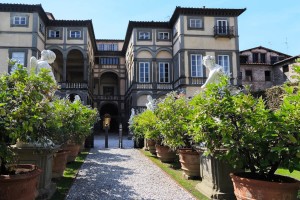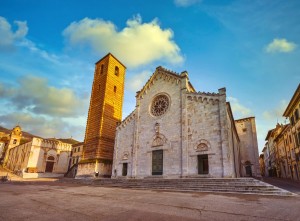An exciting city with a vast musical heritage awaits curious visitors in the northwest of Tuscany. Lucca is the birthplace of famous composers such as Giacomo Puccini, Alfredo Catalani and Nicolao Dorati. You additionally get to look forward to a fairly unusual cityscape that retained the original street layout from Roman times and instead expanded outward in later centuries. And then there’s the close proximity to the Ligurian Sea making Lucca a particularly fertile place – the many different gardens with their wide variety of plant species speak for themselves – and ideal starting point for beach trips. Above all, Lucca is a genuine city of arts with an astonishing abundance of extraordinary churches, palaces and secular building. Here we go!
The city of silk weavers
Like many other Tuscan cities Lucca was founded by the Etruscans. It became a Roman colony in 180 BC around the same time as Pisa and Luna near the quarries of Carrara. Julius Caesar, Pompey and Crassus founded the First Triumvirate here. Becoming a municipium, Lucca had no particular significance during imperial times, later pillaged by Odoacer and then extended by the Lombards to become the residence of either a margrave or a duke. It would constitute itself as an independent commune in 1160 after the death of the influential Matilda of Tuscany who left behind, among other things, a multi-decade battle among her heirs.
Internal discord and repeated attempts of outside influence put the independence to the test time and time again. Lucca was a rich city, particularly due to its central role in the medieval textile industry with especially colourful silk. Repeated unrest lead to the fleeing of many dyers and silk weavers to Venice. Still, Lucca always managed to free itself, was a democracy, a patrician-aristocratic oligarchy and an independent city republic until victorious French revolutionary armies ended the Austrian dominance over Italy and introduced a modern French form of “democracy” with dependence on Napoleon to the region, even Lucca. This quickly turned into a monarchy with Napoleon’s sister Elisa Bonaparte Baciocchi as Princess of Lucca, a Bourbon-Parma duchy after the Congress of Vienna, later a part of the Grand Duchy of Tuscany and the eventual incorporation into the newly founded Italy.
The old city walls
One of the things that makes Lucca unique is its unusual yet highly exciting layout. The rectangular network of roads in the historic centre can be traced back to original Roman structures. Instead of getting rid of them – only the ancient city walls were torn down to free up expansion space – the city was gradually extended outward. Construction of the current city walls only began in the Middle Ages and saw an expansion during the 16th and 17th century giving them today’s form. Actually, they never had to be used for defensive purposes yet prevented potentially devastating flooding in 1812.
Nowadays you can take relaxing walks on the city walls as well as across and through the fortifications giving you a great first impression of Lucca’s architectural diversity and a chance to delightfully relax in quieter, green areas. You probably won’t be surprised to hear that these parts of the city are frequently used for (sporting) events. Five city gates connect the historic centre to the outer districts in almost all directions. Another two old gates from the original medieval site have since been incorporated into the inner ring of walls.
Ecclesiastical Lucca
Lucca has an abundance of churches and basilicas like many other Italian cities. Rather impressively, however, many of those ecclesiastical buildings date back to the Middle Ages and survived the centuries pretty excellently. Let us introduce you to some of our favourites:

©Bigstock.com/goga18128
- San Martino: Lucca’s cathedral was built in the late 12th century and looks almost modern when compared to other churches in the city. There’s a consciously irregularly stepped row of arcades in front of the façade acting as a sort of decorative layer. Behind it you discover a tall, monumental building with glorious paintings, an impressive sarcophagus and a classic finger labyrinth.
- San Michele in Foro: Find the second-most important church in the city, only slightly older than San Martino, on the old Roman market square. The façade was originally built for a nave that should’ve been much high. As you can see, plans changed making the richly adorned outer wall look disproportionally high.
- San Frediano: Unlike many other buildings the façade of this Romanesque basilica minor faces the east in order to avoid visual conflicts with the then newly built city wall. As such, San Frediano looks a bit unusual. A small mosaic part was put onto the wide lower façade construction in order to adapt to the raised nave walls.
- San Francesco: While extended construction periods certainly aren’t a rarity, San Francesco’s is one to behold. Starting out in the 13th century during the transition between Romanesque and Gothic, the upper part of the façade wasn’t completed until the first half of the 20th century utilising historicising methods and styles.
- San Salvatore: The convent Santa Giustina was given its own church in the year 1009. However, the ravages of time took their toll on San Salvatore which is why only little of the original 12th century renovation is left. Everything else can be traced back to much, much later periods. Still, this simple yet impressive church of the since dissolved convent is pretty awe-inspiring, especially on the inside.
- San Giusto: This Romanesque 12th century church replaced a much older building on the square of the same name. The striped upper main façade using black and white marble with its two loggias is very striking. Guidetto’s eye-catching main portal certainly is among his best works.
Secular buildings and gardens
But that’s most definitely not all your tour through the city of arts Lucca has to offer by a long shot. We have a few additional highlights for you:
- Villa Olivia: Lucca is rich in villas and palaces with massive gardens. Knowing this, you won’t be surprised to hear that Villa Olivia almost pales in comparison to its five-hectare-large, walled garden. Two fountains, ostentatious statues and figurines, alleys and amphitheatres lead through this facility.
- Palazzo Ducale: Destroyed palaces and fortifications eventually gave away to Palazzo Ducale, likely during the 15th Its massive and yet partially unfinished facades and rooms are home to galleries and multiple works of art.
-

©Bigstock.com/stevanzz
Palazzo Pfanner: The former Palazzo Controni features a salon with awe-inspiring frescoes and a collection of surgical tools by the namesake Dr Pietro Pfanner. Today’s art museum is surrounded by another stunning garden with numerous statues.
- Casa di Puccini: The birthplace of the world-famous composer, a fairly non-descript building near Piazza San Michele, has been converted into a museum exhibiting original scores and libretti. Among the main attractions is the attic room styled after Puccini’s opera “La bohème”.
- Torre dell’Orologio: There were many towers of rich families in Lucca during the Middle Ages. They were partially built for protection and partially served as a status symbol. One of the few remaining towers, the tallest one in all of Lucca, is the clocktower Torre dell’Orologio. You can scale the many stairs and take a look at the sophisticated clockwork.
- Orto Botanico: How about an entire botanical garden for a change? Established by Marie Louise, Duchess of Parma, in 1820, this stunning facility lends itself to quiet, extended walks – open daily during the warm months and on weekday mornings during off-season.
As you can see, Lucca has a lot of spectacular things to offer with its mix of grand architecture, eventful history plus a number of walks and green areas. Look forward to the almost perfect symbiosis of harmony, peace, touristic highlights and magical time travel in this city of arts in the northwest of Tuscany.